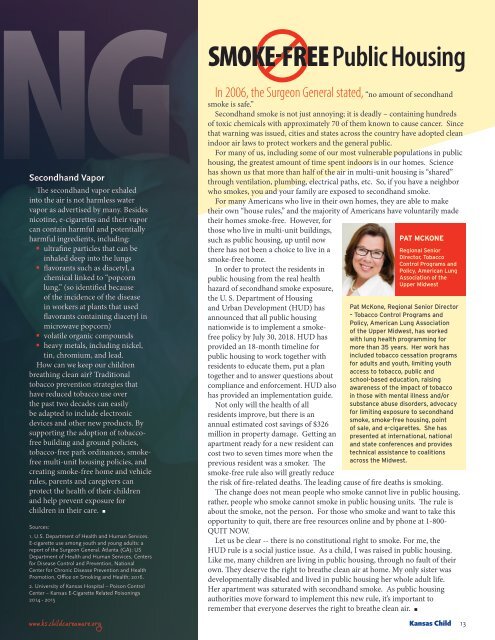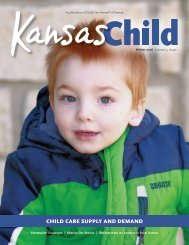2018 Winter Kansas Child
Public Health
Public Health
- No tags were found...
You also want an ePaper? Increase the reach of your titles
YUMPU automatically turns print PDFs into web optimized ePapers that Google loves.
Secondhand Vapor<br />
G<br />
In<br />
The secondhand vapor exhaled<br />
into the air is not harmless water<br />
vapor as advertised by many. Besides<br />
nicotine, e-cigarettes and their vapor<br />
can contain harmful and potentially<br />
harmful ingredients, including:<br />
•§<br />
ultrafine particles that can be<br />
inhaled deep into the lungs<br />
•§<br />
flavorants such as diacetyl, a<br />
chemical linked to “popcorn<br />
lung,” (so identified because<br />
of the incidence of the disease<br />
in workers at plants that used<br />
flavorants containing diacetyl in<br />
microwave popcorn)<br />
•§<br />
volatile organic compounds<br />
•§<br />
heavy metals, including nickel,<br />
tin, chromium, and lead.<br />
How can we keep our children<br />
breathing clean air? Traditional<br />
tobacco prevention strategies that<br />
have reduced tobacco use over<br />
the past two decades can easily<br />
be adapted to include electronic<br />
devices and other new products. By<br />
supporting the adoption of tobaccofree<br />
building and ground policies,<br />
tobacco-free park ordinances, smokefree<br />
multi-unit housing policies, and<br />
creating smoke-free home and vehicle<br />
rules, parents and caregivers can<br />
protect the health of their children<br />
and help prevent exposure for<br />
children in their care. n<br />
Sources:<br />
1. U.S. Department of Health and Human Services.<br />
E-cigarette use among youth and young adults: a<br />
report of the Surgeon General. Atlanta (GA): US<br />
Department of Health and Human Services, Centers<br />
for Disease Control and Prevention, National<br />
Center for Chronic Disease Prevention and Health<br />
Promotion, Office on Smoking and Health; 2016.<br />
2. University of <strong>Kansas</strong> Hospital – Poison Control<br />
Center – <strong>Kansas</strong> E-Cigarette Related Poisonings<br />
2014 - 2015<br />
SMOKE-FREE Public Housing<br />
2006, the Surgeon General stated, “no amount of secondhand<br />
smoke is safe.”<br />
Secondhand smoke is not just annoying; it is deadly – containing hundreds<br />
of toxic chemicals with approximately 70 of them known to cause cancer. Since<br />
that warning was issued, cities and states across the country have adopted clean<br />
indoor air laws to protect workers and the general public.<br />
For many of us, including some of our most vulnerable populations in public<br />
housing, the greatest amount of time spent indoors is in our homes. Science<br />
has shown us that more than half of the air in multi-unit housing is “shared”<br />
through ventilation, plumbing, electrical paths, etc. So, if you have a neighbor<br />
who smokes, you and your family are exposed to secondhand smoke.<br />
For many Americans who live in their own homes, they are able to make<br />
their own “house rules,” and the majority of Americans have voluntarily made<br />
their homes smoke-free. However, for<br />
those who live in multi-unit buildings,<br />
such as public housing, up until now<br />
there has not been a choice to live in a<br />
smoke-free home.<br />
In order to protect the residents in<br />
public housing from the real health<br />
hazard of secondhand smoke exposure,<br />
the U. S. Department of Housing<br />
and Urban Development (HUD) has<br />
announced that all public housing<br />
nationwide is to implement a smokefree<br />
policy by July 30, <strong>2018</strong>. HUD has<br />
provided an 18-month timeline for<br />
public housing to work together with<br />
residents to educate them, put a plan<br />
together and to answer questions about<br />
compliance and enforcement. HUD also<br />
has provided an implementation guide.<br />
Not only will the health of all<br />
residents improve, but there is an<br />
annual estimated cost savings of $326<br />
million in property damage. Getting an<br />
apartment ready for a new resident can<br />
cost two to seven times more when the<br />
previous resident was a smoker. The<br />
smoke-free rule also will greatly reduce<br />
PAT MCKONE<br />
Regional Senior<br />
Director, Tobacco<br />
Control Programs and<br />
Policy, American Lung<br />
Association of the<br />
Upper Midwest<br />
Pat McKone, Regional Senior Director<br />
– Tobacco Control Programs and<br />
Policy, American Lung Association<br />
of the Upper Midwest, has worked<br />
with lung health programming for<br />
more than 35 years. Her work has<br />
included tobacco cessation programs<br />
for adults and youth, limiting youth<br />
access to tobacco, public and<br />
school-based education, raising<br />
awareness of the impact of tobacco<br />
in those with mental illness and/or<br />
substance abuse disorders, advocacy<br />
for limiting exposure to secondhand<br />
smoke, smoke-free housing, point<br />
of sale, and e-cigarettes. She has<br />
presented at international, national<br />
and state conferences and provides<br />
technical assistance to coalitions<br />
across the Midwest.<br />
the risk of fire-related deaths. The leading cause of fire deaths is smoking.<br />
The change does not mean people who smoke cannot live in public housing,<br />
rather, people who smoke cannot smoke in public housing units. The rule is<br />
about the smoke, not the person. For those who smoke and want to take this<br />
opportunity to quit, there are free resources online and by phone at 1-800-<br />
QUIT NOW.<br />
Let us be clear -- there is no constitutional right to smoke. For me, the<br />
HUD rule is a social justice issue. As a child, I was raised in public housing.<br />
Like me, many children are living in public housing, through no fault of their<br />
own. They deserve the right to breathe clean air at home. My only sister was<br />
developmentally disabled and lived in public housing her whole adult life.<br />
Her apartment was saturated with secondhand smoke. As public housing<br />
authorities move forward to implement this new rule, it’s important to<br />
remember that everyone deserves the right to breathe clean air. n<br />
www.ks.childcareaware.org <strong>Kansas</strong> <strong>Child</strong> 13
















